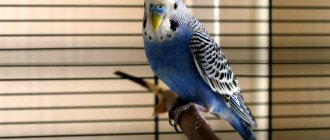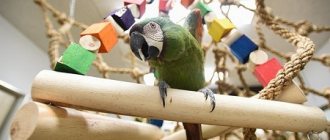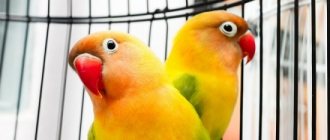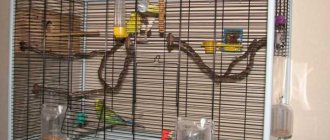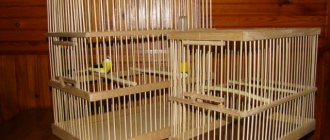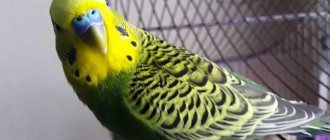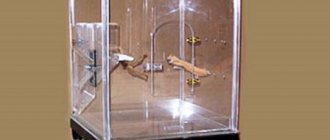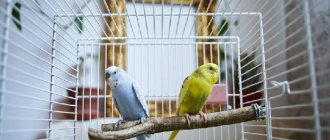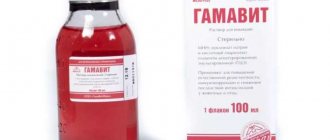The house finally has a pet bird - a parrot! Often, at the same time as purchasing a bird, you also purchase a house for the bird, but what to do if you have purchased a large parrot that still needs a large cage-aviary?
If you really want, you can make such a house yourself at home.
Description
To keep a parrot in captivity, you will need certain devices that satisfy its basic needs. One of them is a bird cage, which ensures the safety of a pet in a person’s home.
On the market you can find a large number of cages of various shapes, sizes, and materials. Their prices also vary widely. There are inexpensive small models for keeping budgies or huge all-metal structures, more like indoor aviaries for large species of birds.
You can design a cage for your pet yourself, which allows you to take into account the individual characteristics of this individual. The main criteria for evaluating a product are design, size, material.
Description of homemade cages for parrots
There are the following types of housing:
- With all metal connection.
The cage is assembled from a mesh or lattice, fastened by spot welding or special devices.
- Combined option.
A plastic or wooden frame holds a metal lattice or mesh.
- All wooden or plastic cages.
They are less common, as they are not very durable and are quickly destroyed by the strong beak of the bird. The mesh and tray are made of the same materials.
Paper parrot: an easy way, step-by-step instructions
Children will definitely love this paper parrot, as it is very easy and quick to make. You can experiment with colors and combine a variety of bright shades. It is based on just a small piece of triangular-shaped paper and a few simple complementary details in the form of a beak, eyes, wings and paws.
Materials for work:
- Double-sided colored paper or cardboard of any shades;
- White paper for eyes or purchased moving eyes;
- A simple pencil, scissors, glue stick.
Optimal size and shape
The dimensions of the structure depend on the type and number of parrots that will live there. It should be such that the pet can freely flutter from place to place without touching the bars. For different breeds of birds, there are minimum acceptable housing sizes.
Optimal sizes for a cage
A large cage of at least 100x100x170cm will be required to keep a macaw, cockatoo or amazon. Also, not very small housing is needed for a pair of medium-sized parrots or a flock of tiny birds. The minimum acceptable proportions are 30x40x50 cm, suitable for a wavy bird or lovebird.
The best cage shape is rectangular with a flat roof surface, as there are breeds that like to run along the walls and ceiling of their house. In addition, a platform is formed on the surface of the cage where you can place a game stand.
If the owner likes the round configuration, it must be taken into account that the pet in such a home loses its bearings. He will not feel safe, as his instinct is to hide in a corner if threatened.
Some tips
1. Do not use galvanized wire, but regular wire, since galvanized wire is more expensive and paint on zinc does not hold up as well. 2. Entrust the alignment of the wire and cutting into segments to turners, this will save you a lot of time and nerves. 3. The connection of the mesh to the frame can be done by welding (semi-automatic). 4. It is best to take painting seriously and find people in your city who can apply powder coating. But it is imperative that the cage be sandblasted before doing this. 5. You can simplify the cage a little and completely cover the back wall with laminate or chipboard. As a rule, the cage is still located against the wall, so only debris will fall from behind, plus this is additional protection from drafts. The disadvantage of a solid wall is that you need to immediately think about where the perches will be placed, since holes need to be drilled. And if the perch is then rearranged, the parrot can chew the hole that appears to such a size that it can crawl out on its own.
A suitable place for a cage in an apartment
Exotic birds are very sensitive to external conditions, so the home of a cockatiel or a pet of another species should be in a place where the bird will be comfortable.
Choosing a suitable location to install the cage
Basic requirements for cage location
The basic requirements for the location of a parrot cage are as follows:
- No draft.
- Away from heating appliances and air conditioning.
- Not in direct sunlight.
- At a sufficient distance from speakers, radio, TV, computer.
- Near the wall, at least on one side.
- The place should not be accessible to a large number of people.
- You cannot place the cage in the kitchen, workshop or other room where there is a lot of fumes and strong odors.
How to reduce stress
Even the most proper cage is a new and unusual home for a parrot. If you just brought your animal home, take care to maintain its comfort and calm. Cover the cage with fabric to give the parrot the illusion of shelter. Do not shout or make noise near the cage, do not play music, and do not allow children to look at the parrot every minute. To prevent the occurrence of health problems due to the stress that occurs when moving to a new home, it is recommended to give the bird special medications. An example of such a product is “Radostin Antistress”. The drug has a convenient liquid form, is used, among other things, for the prevention and treatment of hypovitaminosis, metabolic disorders, reduces the time required for adaptation to new conditions and improves appetite.
Required materials and tools
Wire
Strong steel wire will do. It should not be galvanized or painted, otherwise the pet may be poisoned. The thickness depends on the type of bird and the strength of its beak. For small breeds, a diameter of 1.5-2 mm is suitable, and for macaws and cockatoos - 5-5.5 mm.
Cage for budgies. Size 0.8 x 0.7 x 0.4 m.
Metal corner and profile
Metal corners for fastenings must match the width of the wooden slats. It is unacceptable for them to protrude beyond the frame.
Tree
It is a more preferable material than plastic. It should not contain any toxic glue or paint solutions. The stand or pallet should be made of ash, oak and other hard types of wood; branches of fruit trees are suitable for perches. You cannot use conifers, lilacs or acacias for work, as they contain dangerous glycosides.
Chipboard or plywood
It is advisable to make the bottom part of the product from fiberboard. Unlike plywood, one side of the fiberboard is coated with a water-repellent layer, which allows you to keep the cage clean and makes cleaning easier.
Finches, DIY bird cage part 1
Nails, self-tapping screws, screws with stops
Consumable small parts must correspond to the dimensions of the wooden blanks. The screws that are screwed in should not stick out on the other side. The thread pitch is selected in such a way that the wood does not split during screwing. The required drill diameter options are carefully selected so as not to damage the material being processed.
Wire cutters
Like tin snips, they are needed for cutting wire or mesh.
Net
Its thickness is subject to the same requirements as the wire. The size of the holes should not be larger than the bird's head to prevent the pet from getting stuck or injured.
Metal scissors
Necessary for cutting metal mesh or wire to fit the dimensions of the structure.
HOW TO MAKE A CAGE FOR A PARROT WITH YOUR OWN HANDS
Wood hacksaw
A hacksaw and a jigsaw are sawing tools that you cannot do without during carpentry work.
Screwdriver or screwdriver
A Phillips screwdriver is usually used. You can also use a screwdriver, which is easier and faster to work with.
I completely forgot to tell you about the cage door
The door is quite large, 17.5 x 57.7 mm, so that you can reach any corner of the cage through it. I couldn’t find small canopies for attaching the door to fit on a 10mm square, so I decided to install the door on a d3mm pin. There is a through pin at the top so that if something happens the door can be removed.
As for the lock, I used a small bolt on a spring for these purposes. The bolt is attached to a plate located on the back of the mesh. I would like to note that there should not be any nuts inside the cage, since parrots can unscrew them, so it is necessary to cut a thread in the plate.
I decided to make the utility compartment doors sliding. For these purposes, I purchased glass runners, which are used in chipboard furniture. However, instead of glass, I used 4mm thick PVC plastic (fibreboard could have been used), because of the small child in the house.
The plastic was covered with self-adhesive film, as were the sides of the utility compartment.
Now, you can stock the household compartment with food, treats, chews and all the necessary equipment.
The cage is not yet completely ready (the only thing left to do is install the feeders and screw on the perches), so to be continued...
Added on September 10, 2015.
Drawings and step-by-step assembly instructions
Make a drawing of the future bird house. At the same time, take into account the size of the parrot, behavior, favorite activities and your own preferences.
You can look for convenient and comfortable cages on the Internet, and use them to create your own version.
Remember! Metal elements must be processed so that the bird does not get hurt on them, and wooden elements are sanded.
DIY bird cage.
- According to the modular principle, the underbody, side walls and roof are first assembled separately. Then they are attached to each other.
- First, the pallet is cut out from four bars, then the bottom itself, preferably from a sheet of chipboard. It is the basis of the cell. The parts are fastened together with nails or self-tapping screws strictly outward.
- Already sized metal corners are attached to the bottom, to which the adjacent side walls made of mesh are then screwed.
- When the frame is ready, work is done to secure the roof. It is recommended to make it from solid material, to which you can attach accessories for your pet - swings, bells, mirror, etc.
- The back wall is mainly made of galvanized iron.
- It is also recommended to “put” the house on wheels to make it easier to move.
- Don't forget the hole for the hinged door.
- The component elements are assembled into one common structure.
Toys for budgies
Parrots are very smart and curious birds, so they need to organize their leisure time. First of all, the owner’s responsibility is to constantly communicate with the pet, but it is also worth leaving him time to spend time alone with himself. Toys placed in the cage will help with this. But it would be a big mistake to assume that a parrot’s home should be overloaded with a huge number of things for entertainment. It is worth remembering that each bird has its own character and preference. Some toys simply will not arouse interest in your pet, but at the same time he may be completely delighted with a simple bolt suspended on a string.
The main toys that budgies most often prefer are a bell, a rocker and a ladder.
In any case, when choosing things for entertainment, you need to pay attention to the quality and durability of the materials. You should not allow your pet to start breaking off parts of the toy with its beak and eating them.
This can lead to poisoning or disruption of the digestive system. The chains on which toys are usually hung, especially bells, can also pose a danger. Sometimes your parrot's toes get stuck in them, which can cause injury.
Special beads, coconut shells, and rings can be used as toys. There are toys that are designed for the cage; they help not only organize leisure time, but also serve as a crossbar, for example, rings, swings. Bells have an entertainment function. There may also be toys for fitness, puzzles, and interactive ones. They need to be selected as needed, focusing on the preferences of a particular individual.
Do not forget that parrots do not like innovation and change. Therefore, they may need time to get used to a new object in the cage and study it. Or the thing will not arouse interest at all.
You can make some toys yourself, the main thing is to take care of the strength of the materials and the safety of their use.
Equipping a cage at home
Perches
Perches are located at different levels, 2-3 in number, so that the bird can fly from one to another. It is desirable that they are made of wood. Plastic products are too hard and rub the pet’s paws, forming rough calluses on them and preventing the natural grinding of the claws.
Homemade bird cage with your own hands. How and from what to make it.
To make a perch with your own hands, take the branches of the following trees:
- Apple tree;
- ash;
- plum;
- aspen;
- alder;
- cherry;
- birch;
- beech;
- Linden;
- hazelnut or walnut;
- chestnut;
- maple;
- viburnum.
It is strictly prohibited to use branches of coniferous trees, as well as acacia, elderberry, poplar, bird cherry, lilac, oak and pear.
DIY bird cage. How to do it yourself.
The blanks are collected in an environmentally friendly place, far from landfills, factories, and roads. Garden trees are used only if they have not previously been treated with pesticides against pests. Future bird perches must first be inspected for the presence of insects, cleaned of sharp twigs, rinsed with warm water, and doused with boiling water. The bark is a source of vitamins and minerals, so it is left.
For the grinding effect of the claws, products made of volcanic pumice or perches coated with special minerals are suitable. Products are produced with replaceable nozzles. They are environmentally friendly and safe for poultry, but it is still better to use them as additional ones.
The diameter of the product must correspond to the size of the feathered legs, and be such that the pet clasps the perch by about 2/3. His fingers should lie on the surface without hanging, and his claws should touch the branches. Perches with a thickness of 1.5 cm or more are suitable for a budgie.
The length is selected taking into account the longitudinal and transverse dimensions of the pet’s home - the perch should protrude beyond its limits by 5-7 mm. A large piece of driftwood can be placed whole in the cage of large bird species.
DIY parrot cage
To make your own additive you will need garden pruning shears, a knife or saw, a tape measure and sandpaper. Next, the work is performed in several stages:
- We measure the width of the cage.
- Cut the branch slightly longer than the specified size.
- At each end of the workpiece we make a small cut into which the rod of the wall of the dwelling should fit. If you plan to install an additive at the joint of a mesh or wire, then it is made cross-shaped.
- We fasten the resulting product in the designated place.
Homemade perches must be replaced when the parrot peels off the bark from them.
Drinkers and feeders
For each type of food, your pet needs to install a feeder in the cage. Usually their number is at least three, under:
- grain mixture;
- juicy food of plant origin;
- mineral supplement.
Cage for budgerigars
For small breeds of birds, you can use a plastic product of an external hinged type; for medium and large parrots, stainless steel bowls are installed. Such models are equipped with special clamps or rings with hooks that allow them to be attached to the wall of the cage. Floor feeders are installed when a flock of birds live together to reduce their bullying or near a sick, exhausted individual. The disadvantage of such devices is the rapid contamination of the contents. They are also not suitable for timid or aggressive birds, since the owner needs to stick his hand into the cage to change food.
In this regard, external mounted feeders are better than the previous ones and do not take up extra space in the parrot’s home. However, they also have their drawbacks. Some pets are able to knock the dishes out of the fastening and escape through the resulting hole. The bird can also get stuck inside the product and even die. In addition, the design is usually suitable only for a certain type of cell, which makes it extremely difficult to replace a device that has become unusable.
We are building an aviary for parrots - Results. How to make a bird aviary
There are also automatic bunker feeders. The food in them always remains clean and is fed gradually as the bird eats the mixture, which allows you to pour a large amount of it for a long time. One of the disadvantages is a small hole, which, if clogged, risks leaving the parrot hungry. It will also be difficult to control the amount of food, which is important for birds prone to overeating and obesity.
Homemade feeders are usually made with internal hinged ones. Secure a small container or coconut shell to the side of the cage using thick wire. To prevent food from becoming contaminated, build an improvised lid for the product. You can attach a wooden perch from a small stick to the bowl for the parrot's comfort.
Clean, fresh water should always be available to your pet. To do this, install a drinking bowl in the cage.
The most hygienic option is an automatic dish. Drinks in open containers quickly become contaminated. Some birds deliberately throw food, various objects or pieces of paper into the water, and some also try to swim there.
Gor-blog / DIY parrot cage
Useful little things
Also, when choosing a cage, you need to pay attention to a few little things. For example, doors should open easily and close tightly
Moreover, it is advisable to give preference to swing ones rather than lifting ones.
The fact is that parrots are generally distinguished by their ingenuity. They are quite capable of opening simple latches, deftly using their claws and beak. And then lift the door to get out. Unfortunately, it is precisely at this moment that the lifting mechanism often falls, and if it hits the neck, it pinches the bird’s head. Usually the parrot can no longer lift it and simply tries to escape, receiving serious wounds. A swing door is much safer in this regard.
We should not forget about the pallet. Be sure to choose a cage with a retractable product. It is very easy to clean - just pull it out, shake out the accumulated debris and rinse with warm water. If there is no retractable tray, then you will have to remove debris with a vacuum cleaner or manually, and then wash the bottom with a damp sponge - a much more difficult job that takes much more time.
Subtleties of manufacturing
The choice of cage dimensions for songbirds directly depends on their size. For miniature birds, a small structure made of plastic or metal is suitable. It is best to choose a rectangular shape. The perches in such a cage are located at different heights, which will help its inhabitant move from top to bottom with ease. In this case, the drinking bowl and container with grain are placed on the floor of the “dwelling.” It is better to make the tray retractable to make it easier to keep the cage clean.
Round designs are no less popular. Large vintage checks look very impressive. Such a house for birds can be equipped with swings, perches and other bright accessories.
This cage can also be hung or conveniently placed on a hard surface.
For large birds it is necessary to build an aviary cage. In most cases, the structure is made of metal. This model implies the presence of several tiers and a large door. Various devices are attached to the ceiling of the enclosure (for example, perches, rings, etc.).
Varieties
Pet stores offer a huge number of toys made from various materials and designed for wavy animals. They can be used inside or outside the cage and have different functions.
Some things are needed to sharpen the beak and nails, while others develop intelligence. There must be toys designed for the full physical development of the pet.
Before purchasing a finished product, it is important to make sure that there are no glue residues or small objects on the surfaces that the parrot could tear off and swallow.
For sharpening the beak
The beak of the wavy is covered on top with a horny layer, which is easily ground off.
To do this, the parrot must have constant access to special objects that are used to sharpen its beak. You can use special toys made of wood or plastic.
The basic rule to follow is the safety of the material used. Typically, such toys are represented by a dummy bird, wooden sticks attached to the wall of the cage, as well as perches with unusual protrusions.
Intelligent
Their purpose is to develop the mental abilities of the bird. They are represented by special educational puzzles, upon solving which the bird gains access to some kind of delicacy.
Usually labyrinths or special balls are used for these purposes, which are closed on several sides, but have recesses into which the wavy can insert its beak. With regular use of such toys, the pet becomes more intelligent, and this often has a positive effect on the speed of speech learning.
Do you buy toys for your parrot?
Not really
For physical development
Since pet parrots don't move much, they require special items to help them maintain optimal physical condition. For this purpose, special rings, perches, bungees and ladders are used.
But it is not recommended to overdo it with these elements, since otherwise the parrot simply will not have room for quiet rest and relaxation. You need to place purchased or made elements at different heights.
Interactive
They consist in the fact that the bird must perform certain actions in order to receive a certain delicacy. Sometimes such toys produce sounds when pressed, which arouses the parrot's interest.
Some birds do not understand what needs to be done with an interactive toy, so the human task is to show the principle of operation of the item.
Is an aviary required?
A parrot aviary is an excellent solution for keeping a large bird or several regular-sized birds. Pets are able to fully enjoy freedom. In addition, many breeds can only reproduce in such conditions. Also, in the warm season, you can put your home on the balcony, where in the open air the parrots’ immunity is significantly strengthened and molting goes better.
Among the disadvantages is the area occupied by the enclosure. In addition, if you keep several birds in it at once, then if one of them gets sick, it may be difficult to isolate it and prevent an epidemic. Parrots living in a group are less trainable.
Features of building an aviary
When building an aviary for parrots, it is worth remembering the following features.
This:
- For ease of cleaning, you should try to make the structure collapsible. If this doesn’t work, then you need to make several doors and a fully retractable tray. It can be filled with wood cat litter, which perfectly collects dust and absorbs moisture.
- You need to place the enclosure in a bright corner of the room or place a source of artificial light nearby.
- For shy parrots, it is worth making at least two walls of the home solid.
- Rope ladders and large tree branches can be used as decoration.
